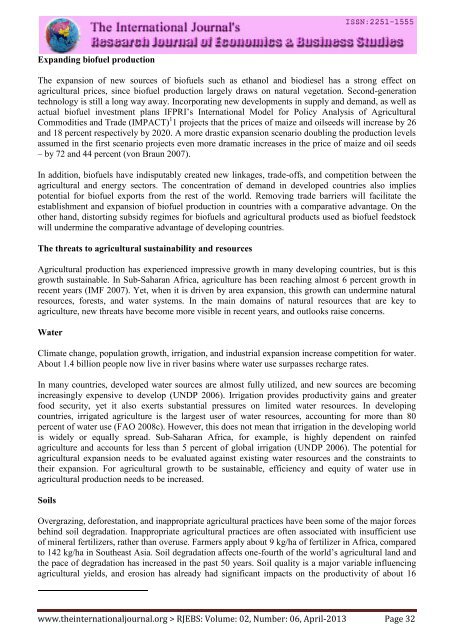Research Journal of Economics & Business Studies - RJEBS - The ...
Research Journal of Economics & Business Studies - RJEBS - The ...
Research Journal of Economics & Business Studies - RJEBS - The ...
- No tags were found...
Create successful ePaper yourself
Turn your PDF publications into a flip-book with our unique Google optimized e-Paper software.
Expanding bi<strong>of</strong>uel production<br />
<strong>The</strong> expansion <strong>of</strong> new sources <strong>of</strong> bi<strong>of</strong>uels such as ethanol and biodiesel has a strong effect on<br />
agricultural prices, since bi<strong>of</strong>uel production largely draws on natural vegetation. Second-generation<br />
technology is still a long way away. Incorporating new developments in supply and demand, as well as<br />
actual bi<strong>of</strong>uel investment plans IFPRI’s International Model for Policy Analysis <strong>of</strong> Agricultural<br />
Commodities and Trade (IMPACT) 1 1 projects that the prices <strong>of</strong> maize and oilseeds will increase by 26<br />
and 18 percent respectively by 2020. A more drastic expansion scenario doubling the production levels<br />
assumed in the first scenario projects even more dramatic increases in the price <strong>of</strong> maize and oil seeds<br />
– by 72 and 44 percent (von Braun 2007).<br />
In addition, bi<strong>of</strong>uels have indisputably created new linkages, trade-<strong>of</strong>fs, and competition between the<br />
agricultural and energy sectors. <strong>The</strong> concentration <strong>of</strong> demand in developed countries also implies<br />
potential for bi<strong>of</strong>uel exports from the rest <strong>of</strong> the world. Removing trade barriers will facilitate the<br />
establishment and expansion <strong>of</strong> bi<strong>of</strong>uel production in countries with a comparative advantage. On the<br />
other hand, distorting subsidy regimes for bi<strong>of</strong>uels and agricultural products used as bi<strong>of</strong>uel feedstock<br />
will undermine the comparative advantage <strong>of</strong> developing countries.<br />
<strong>The</strong> threats to agricultural sustainability and resources<br />
Agricultural production has experienced impressive growth in many developing countries, but is this<br />
growth sustainable. In Sub-Saharan Africa, agriculture has been reaching almost 6 percent growth in<br />
recent years (IMF 2007). Yet, when it is driven by area expansion, this growth can undermine natural<br />
resources, forests, and water systems. In the main domains <strong>of</strong> natural resources that are key to<br />
agriculture, new threats have become more visible in recent years, and outlooks raise concerns.<br />
Water<br />
Climate change, population growth, irrigation, and industrial expansion increase competition for water.<br />
About 1.4 billion people now live in river basins where water use surpasses recharge rates.<br />
In many countries, developed water sources are almost fully utilized, and new sources are becoming<br />
increasingly expensive to develop (UNDP 2006). Irrigation provides productivity gains and greater<br />
food security, yet it also exerts substantial pressures on limited water resources. In developing<br />
countries, irrigated agriculture is the largest user <strong>of</strong> water resources, accounting for more than 80<br />
percent <strong>of</strong> water use (FAO 2008c). However, this does not mean that irrigation in the developing world<br />
is widely or equally spread. Sub-Saharan Africa, for example, is highly dependent on rainfed<br />
agriculture and accounts for less than 5 percent <strong>of</strong> global irrigation (UNDP 2006). <strong>The</strong> potential for<br />
agricultural expansion needs to be evaluated against existing water resources and the constraints to<br />
their expansion. For agricultural growth to be sustainable, efficiency and equity <strong>of</strong> water use in<br />
agricultural production needs to be increased.<br />
Soils<br />
Overgrazing, deforestation, and inappropriate agricultural practices have been some <strong>of</strong> the major forces<br />
behind soil degradation. Inappropriate agricultural practices are <strong>of</strong>ten associated with insufficient use<br />
<strong>of</strong> mineral fertilizers, rather than overuse. Farmers apply about 9 kg/ha <strong>of</strong> fertilizer in Africa, compared<br />
to 142 kg/ha in Southeast Asia. Soil degradation affects one-fourth <strong>of</strong> the world’s agricultural land and<br />
the pace <strong>of</strong> degradation has increased in the past 50 years. Soil quality is a major variable influencing<br />
agricultural yields, and erosion has already had significant impacts on the productivity <strong>of</strong> about 16<br />
www.theinternationaljournal.org > <strong>RJEBS</strong>: Volume: 02, Number: 06, April-2013 Page 32

















